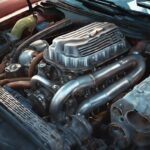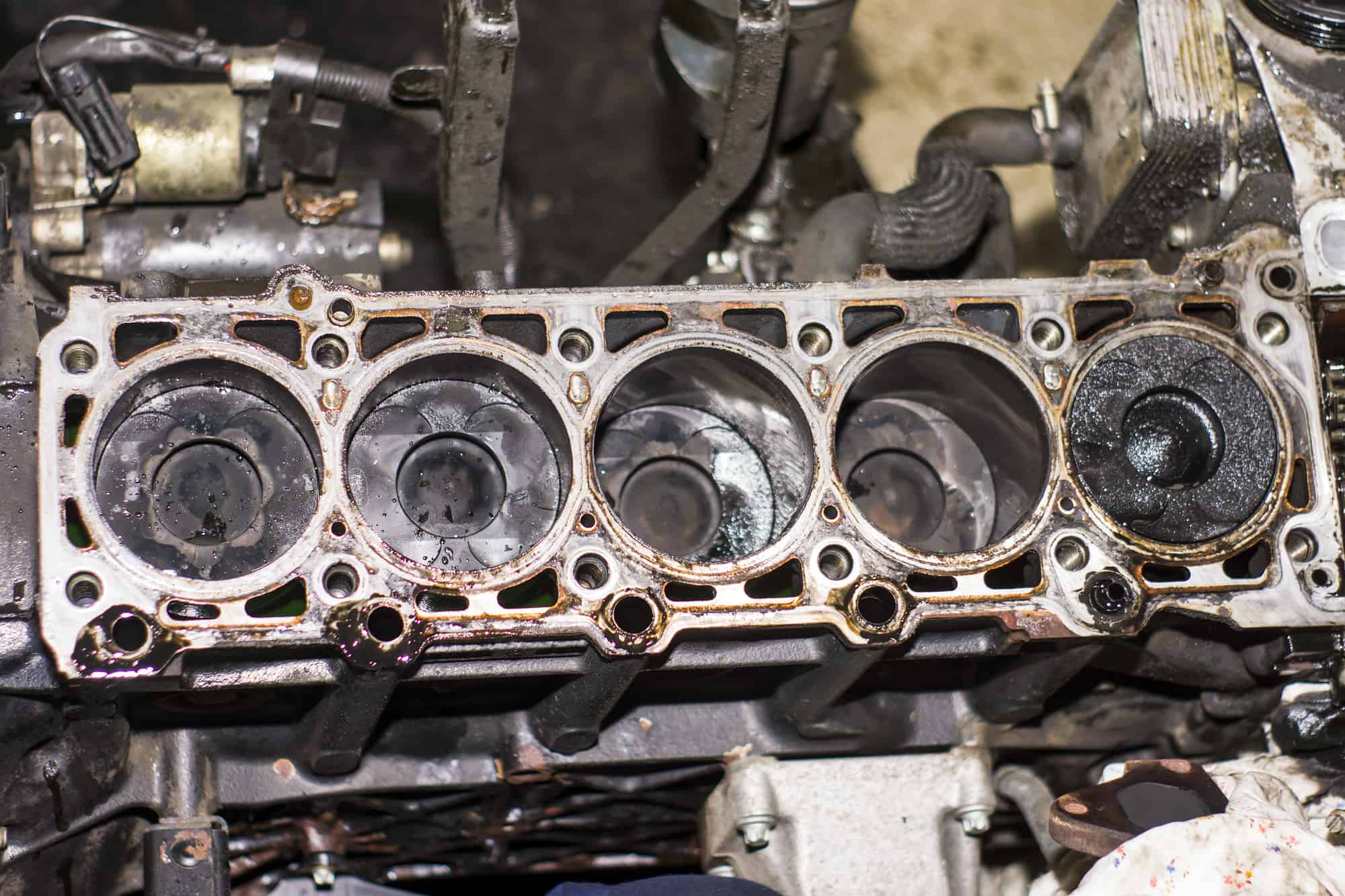A cracked cylinder head is usually associated with lower engine compression and engine overheating. If the crack causes an internal engine leak, then engine oil can start to mix with engine coolant, leading to low oil pressure.
As a general rule, yes, a cracked cylinder head will cause low oil pressure. This is caused by coolant and oil mixing, leading to a change in oil volume and viscosity. This makes it more difficult for the engine to maintain adequate oil pressure.
A crack in the cylinder head is usually caused by the engine overheating. Overheating is often caused by low coolant levels that may in turn be caused by a failed head gasket. Cracks can form over a period of time if the engine is continuously overheating and cooling. The extreme changes in temperature cause the cylinder head to warp and this allows cracks to emerge in the cylinder head alloy.
As an Amazon Associate we earn from qualifying purchases.
How does a cracked cylinder head affect oil pressure?
A cracked cylinder head will cause a drop in coolant levels and a drop in coolant system pressure. If the cylinder head gasket is blown, coolant and oil will mix, causing a drop in oil pressure, especially if the engine oil is leaking into the coolant system within the engine.
It’s important to note that the most common cause of low oil pressure is not having enough oil in the engine, to begin with. This can be simply caused by not topping up the oil regularly. Oil pressure can also be affected by using the wrong oil filter or oil viscosity.
Low oil pressure can also be caused by using the wrong engine oil, a faulty oil pressure sensor, or even a problem with the oil pump. If the low oil pressure is also accompanied by a loss of coolant, then this can signify a cracked cylinder head.
Once a cylinder head cracks, this leads to a drop in combustion pressure in one or more cylinders. Coolant and engine oil will usually leak into the affected cylinder and burn up. Coolant will also find its way into the engine oil and this will change the viscosity of the oil, making it thinner, further reducing the oil pressure in the engine.
Another reason for a drop in oil pressure is the loss of the oil’s protective properties when it becomes contaminated with coolant. This will cause internal damage to the engine and damage to the oil pump very quickly.
Symptoms Of A cracked cylinder head That Causes Low Oil Pressure
A cracked cylinder head frequently occurs at the same time as a blown head gasket. Most of the time, with modern cars, it is the failure of the head gasket that leads to the cracked cylinder head.
Sometimes, a crack in the cylinder head can form over a long time, and it may not have one single cause, rather it is down to engine wear and tear. These types of cracks are often asymptomatic and won’t be associated with a drop in oil pressure.
If the cause of the cracked cylinder is running the engine when it is low on coolant or if it is a blown head gasket, then a drop in oil pressure is almost guaranteed and the following symptoms are most likely to be present.
1. Engine Overheating
Loss of coolant and regular engine overheating is often the first sign of a cracked cylinder head. Low coolant levels are often caused by a leak in the cylinder head or a blown head gasket.
If your engine is overheating quickly after startup or regularly when you are driving in traffic, then the first thing to check is the coolant level. If the engine is experiencing significant coolant loss and it is not caused by something like a blown hose or a leaky radiator, then it is almost certainly an internal leak.
A leak within the engine will usually be accompanied by a drop in compression and a loss in engine power. This also leads to the coolant and engine oil channels losing pressure and leaking fluids into the combustion chamber. When the coolant and engine oil start to mix this will cause a drop in coolant level in the engine and in the coolant reservoir along with a drop in engine oil pressure.
2. Low coolant with no external leaks
Another very common symptom of a crack or leak within the engine is a loss of a significant amount of engine coolant over a short period of time, with no external leaks present.
The engine block and the cylinder head are joined in most engines by a head gasket that keeps the combustion chambers sealed, as well as keeping the engine oil and coolant separated from each other.
A crack in the cylinder head or a blown head gasket will lead to a loss of coolant into the combustion chamber where it will burn off as white smoke in the exhaust. This will lead to the loss of coolant very quickly, without any detectable leaks.
3. Brown/white engine oil
Another common symptom of a cracked cylinder head that causes low oil pressure is the mixture of coolant and engine oil within the engine. This can be easily spotted by checking the coolant or engine oil for cross-contamination. Coolant in the oil will lead to a watery brown, milky oil mixture
If the head gasket has failed at any point across the engine block then coolant will usually make its way into the engine oil that is lubricating the pistons and valves.
If enough coolant gets into the engine oil then this will drastically affect the lubricating properties of the oil and can lead to severe engine damage quickly. It’s usually pretty easy to spot coolant that has mixed with engine oil. Removing the oil filler cap will often reveal a brownish/white milky substance on the back of the cap. On some vehicles, you may be able to see into the top of the engine and the cylinder head by shining a torch in the oil filler cap hole.
4. Excessive white smoke from the exhaust
If there is a constant stream of white exhaust smoke when you are driving, then this can indicate a cracked cylinder head that is leaking coolant into the combustion chambers. It’s important to note that the white smoke must be there all of the time, not just at engine startup when the engine is cold.
Cold engines can produce white smoke and this is mainly due to condensation in the exhaust pipe and from the engine running rich for a short while to help improve performance until the engine warms up. Sometimes if you’ve got a faulty spark plug, ignition coil or injector, fuel may escape unburnt through the exhaust and this will create white smoke (from the fuel vapor) along with a strong smell of unburnt fuel.
If the white smoke is present all of the time and gets worse under heavy acceleration this can indicate that the coolant is leaking into one or more cylinders and is being burnt with the fuel. The white smoke is produced by the water vapor in the hot coolant escaping through the exhaust.
What next – How to identify and repair a cracked cylinder head that causes low oil pressure?
If you suspect that the cylinder head is cracked then you can perform a few simple checks before you need to strip down the engine to confirm the crack. A cracked cylinder head is not always easy to diagnose, even after you remove the head from the engine and you may need to get a second opinion from an expert that has access to specialist tools and techniques such as magnetic particle detection.
Here are a few simple checks that you can carry out before stripping down the engine.
- Check coolant levels. Start by checking the coolant level in the coolant reservoir. If it is very low then this indicates a leak from somewhere in the system. Top it up with the required coolant mixture and start the engine. Check for external leaks from hoses and pipes, from the radiator and from the joints where hoses join the engine and the radiator. If there is no evidence of a coolant leak then it may be an internal leak caused by a crack in the cylinder head and will need further investigation.
- Check the engine oil. Ensure that the correct amount of engine oil is in the engine and that it is not low. Check the oil for coolant contamination. As outlined above, oil and coolant that has mixed will have a milky brown consistency. If the oil looks ok and there it is not low, then low oil pressure may be caused by something else such as a faulty oil pump.
- Run an engine diagnostic for error codes. Checking the ECU for engine error codes may reveal a problem with the oil pump, the oil pressure sensor or the oil level sensor. If there is no sign of coolant mixing with the engine oil then the problem may not be a crack in the cylinder head. If the ECU is storing error codes such as P0520 (engine oil pressure sensor malfunction) or P0524 (engine oil pressure too low), this may indicate a problem with oil pressure caused by a problem with the oil pump or engine oil sensors.
- Carry out a compression test on the engine. Test each engine cylinder for leaks by carrying out a dry compression test on each one. If any of the results is less than 100PSI then carry out a wet compression test using a small amount of oil to rule out piston ring failure as a possible cause of low oil pressure. If the wet compression test improves the cylinder pressure score then the problem may lie with the pistons and not a crack in the cylinder head.
If another reason for a drop in oil pressure cannot be identified, the next step is to have the cylinder head pressure tested professionally for leaks that may be caused by cracks. Once the engine is stripped down you can also check the condition of the pistons, the piston rings, the valves, and valve seals.
Related Questions
1. How long can an engine run without oil pressure?
Most modern engines will only run for a few minutes at most without oil pressure. In practice, an engine should not be run at all without adequate oil pressure. Low oil pressure in an engine signifies a lack of oil being pumped through the engine and this will cause excessive wear that can lead to engine failure.
Most engines even when idling are running at 700 RPM and much higher when the vehicle is moving. The moving parts inside of the engine require constant lubrication from engine oil to help to keep wear to a minimum and to keep the engine cool. The lower part of the engine, the crankcase, crank, and rod bearings need the most lubrication and can suffer immediate damage without proper lubrication. Newer engines operate with much tighter tolerances and these tiny gaps need constant lubrication to prevent the engine from seizing up.
2. Can you fix a cracked cylinder head?
Yes, you can fix a cracked cylinder head. Small cracks can usually be repaired by a process called pinning. Pinning involves inserting a row of small pins made from the same material as the head into the crack or hole to seal it. The process can be carried out on aluminum and cast iron cylinder heads.
Larger and more complex cracks can be welded using a number of different types of welding. TIG welding is the most common technique used to repair aluminium cylinder heads, whereas furnace or flame spray welding is more common for cast iron heads.
Fixing a cracked cylinder head is not cheap but it can be more cost-effective than replacing the cylinder head with a new one.
3. How long can you drive with a blown head gasket?
You should not drive your vehicle at all if you suspect it has a blown head gasket. A blown head gasket usually implies that the head gasket seal has gone completely and coolant can freely enter the combustion chambers. In this scenario, coolant will be lost very quickly causing the engine to overheat.
If the engine loses all of its coolant then this will cause irreparable damage to the cylinder head and possible the engine block. Even if the head gasket is only leaking a small amount, you should still not drive the vehicle as a leaking head gasket will fail completely at some point.
As an Amazon Associate we earn from qualifying purchases.































Would using a higher grade coolant help in preventing cracks in the cylinder head, or is the issue solely related to overheating and not the type of coolant used?
I’ve been noticing a gradual decrease in my car’s oil pressure and there’s a persistent overheating issue, even though I regularly check and fill the coolant. Could these symptoms indicate a problem that’s related to a cracked cylinder head or is this more likely to be a different issue altogether?